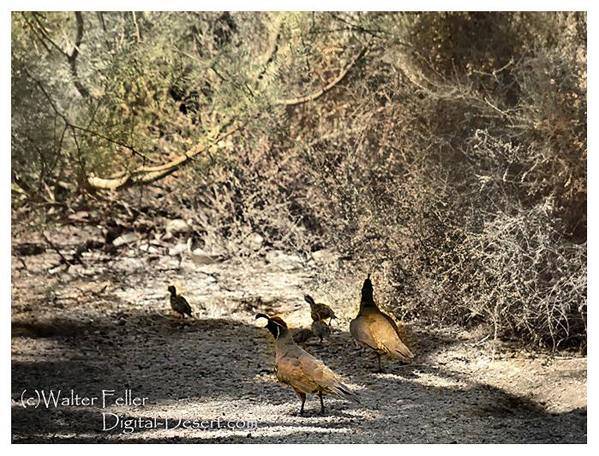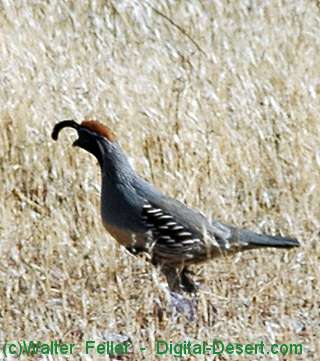Gambel's Quail
Callipepla gambeliiFamily: Odontophoridae Order: Galliformes Class: Aves

DISTRIBUTION, ABUNDANCE, AND SEASONALITY
A common resident of Colorado and Mojave Desert regions of southeastern California.
Preferred habitats include
desert riparian,
and a wide variety of other desert types, especially
near streams, springs, and water holes. Frequents both valleys and steep hillsides.
Associated plants include Baccharis glutinosa, Atriplex, Acacia, Prosopis, Opuntia, and Yucca
(Johnsgard 1973). Also found in Tamarix, but not common in pure stands that now dominate
portions of the Salton Sea district (Garrett and Dunn 1981). Occurs along the
Colorado River,
west to Borrego Valley (San Diego Co.) and the
Mojave River
(San Bernardino Co.). Range
extends north locally in the Mojave Desert to the
Amargosa River,
southern Inyo Co.,
and has
been introduced successfully near
Furnace Creek. Normally found at low elevations, but
ranges up to 1636 m (5400 ft) in the Providence Mts. Successfully introduced to San
Clemente Island, where now common (Grinnell and Miller 1944, Garrett and Dunn 1981).
Range in southern California may have increased following irrigation of deserts.
SPECIFIC HABITAT REQUIREMENTS
Feeding: Forages in open habitats interspersed with patches of shrubs, trees or brush
piles. Adult eats mostly plant material, gleaning forb, shrub, and grass seeds from the ground
surface. Lotus, Lupinus, Astragalus, and Erodium are important (Gullion 1962, Grenfell et al.
1980). Succulent forbs and grasses are highly favored when available (Hungerford 1962).
Chick feeds initially on insects (Harrison 1978), but soon acquires
vegetarian diet.
Cover: Escape cover, usually provided by trees or tall shrubs, required; amount may
control covey size (Grinnell and Miller 1944).
Reproduction: Nest built on the ground in a variety af desert habitats; shaded from direct
sun by low foliage of trees or shrubs (Harrison 1978). Nest typically shallow depression lined
with grasses or other vegetation. Unusual sites in Tamarix and orchard trees, at heights
2.1-6.1 m (7-20 ft), were reported by Neff (1941).
Water: Most commonly seen near water (Grinnell and Miller 1944). Miller and Stebbins
(1964) did not observe a covey more than 2.4 km (1.5 mi) from permanent water at
Joshua Tree National Park. Although
water may be critical in hot summer, it may not be required for drinking at other times, if temperatures and humidities are moderate, and
succulent plants are available to eat (Gullion 1962).
Pattern: Frequents
desert habitats,
preferably with open foraging sites interspersed by
escape cover, with permanent water nearby. In New Mexico, occupies patches of favorable
habitat along irrigation ditches, but apparently croplands little used (Raitt and Ohmart 1966).
SPECIES LIFE HISTORY
Activity Patterns: Yearlong,
diurnal activity. In
early morning, travels by foot to a source of
water, then feeds for several hours (Edminster 1954).
Seasonal Movements/Migration: Non-migratory in California (Grinnell and Miller 1944).
Home Range: Ten coveys in Nevada thorn scrub had home ranges varying from 7.6 to 38
ha (19-95 ac), with a mean of 14.3 ha (35.7 ac) (Gullion 1962). At the same study site,
average population density was 0.64 ha (1.6 ac) per bird. In Arizona, Hensley (1954)
determined breeding densities of 1 pair/6.6 ha (16.6 ac), and 1 pair/3.2 ha (8 ac) at 2 sites.
Territory: Male does not defend a territory, but becomes increasingly aggressive towards
other males as nesting season approaches. This leads to dissolution of winter coveys (Raitt
and Ohmart 1966).
Reproduction: Nesting season of variable duration, depending on rainfall, but usually
begins in April and ends in June or July. Green feed necessary for successful nesting. In
years of low winter or spring rainfall, may not nest at all (Mallette and Slosson 1980). Pair
strongly monogamous (Johnsgard 1973). Clutch size 12-14 eggs (Gorsuch 1934). Usually
single-brooded, but may be double-brooded in wet years (Harrison 1978). Incubation 21-23
days. Female incubates while males guards, but both may brood. Chicks precocial; become
independent by 4 wk (Harrison 1978).
Niche: Adapted to desert living; has tolerance for high temperatures (Henderson 1971)
and saline drinking water (McNabb 1969). Closely related to California quail; the 2 ranges
overlap near San Gorgonio Pass, Riverside Co. (Garrett and Dunn 1981). Hybrids have been
recorded in this area. Also occurs with mountain quail at about 1500 m (5000 ft) in
Joshua Tree National Park. Vulnerable
to Cooper's hawks, sharp-shinned hawks,
great horned owls,
bobcats, and
snakes,
which are described by Leopold (1977) as important
predators
of
California quail. A
favored game species; 350,000 to 400,000 harvested annually in California
(Mallette and Slosson 1980).
Source:
CDFW California Wildlife Habitat Relationships. Accessed [N/A]
https://wildlife.ca.gov/Data/CWHR
Gambel's Quail can be found most abundantly near
waterholes. Individuals
have been found to be living in elevations below sea level in
Death Valley
and up to 6,000 feet in the Pinyon and Juniper forests of desert mountain
ranges. Their distinctive call helps to keep the covey (flock) together
and define territorial boundaries.
Although they tolerate dehydration well, in the winter, huge coveys gather
together to drink from
waterholes if succulent
vegetation is not available.
As they have many
predators they time their arrival at
waterholes and drink
primarily in the early morning and at dusk to avoid
hawks and falcons.
Also see >
Bird:
Prey:
Herbivore:
Diurnal
Habitat:
Cactus-Yucca Scrub

Gambel's Quail
Identification Tips:
Length: 8.5 inches
Small, chunky, short-tailed, round-winged, ground-dwelling bird
Immature similar to female
Adult male:
Black, forward-tilting and teardrop-shaped crest
Black forehead
Chestnut crown
Black face
White border to face
Blue-gray nape, chest, back and upperwings
Yellowish belly with black central portion
Rusty-brown flanks with white streaks
Adult female:
Short, curved, dark brown, teardrop-shaped crest
Gray head, chest, back and upperwings
Chestnut flanks with white streaks
Pale belly
Lacks black throat of male
Similar species:
Mountain Quail has chestnut face, straight head plume and gray crown. California Quail has pale forehead, stippled nape and scaly belly.
Length and wingspan from: Robbins, C.S., Bruun, B., Zim, H.S., (1966). Birds of North America. New York: Western Publishing Company, Inc.